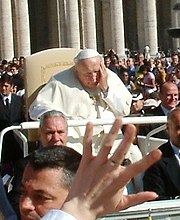Health of Pope John Paul II
From Wikipedia, the free encyclopedia.
Pope John Paul II entered the papacy as a healthy, relatively young man of 58, who hiked, swam and went skiing. However, after over twenty-five years on the papal throne, two assassination attempts (one of which resulted in severe physical injury to the Pope), and a number of cancer scares, John Paul's physical health declined.
The 1981 assassination attempt was costlier to his overall health than was generally known by the public at the time. On the operating table his blood pressure fell dangerously low and his heartbeat was extremely weak, prompting a doctor to advise administration of the Anointing of the Sick (formerly known as "Last Rites"). There were difficulties with blood transfusions and it is believed cytomegalovirus (CMV) was transmitted, complicating recovery. The bullet had passed completely through the body, puncturing the stomach and necessitating a colostomy. Seven weeks later, discussions were held about reversing the colostomy and eight of nine doctors voted against it, arguing the Pope was still too weak from the CMV infection. Saying "I don't want to continue half dead and half alive", the Pope effectively overruled his physicians and the reversal was done successfully on August 5, 1981. Despite the shooting and the complications during recovery, John Paul remained in impressive physical condition throughout the 1980's, and remained active as well. During the 1990's his health began to decline.
An orthopaedic surgeon confirmed in 2001 that Pope John Paul II was suffering from Parkinson's disease, as international observers had suspected for some time; this was acknowledged publicly by the Vatican in 2003. Despite difficulty speaking more than a few sentences at a time, trouble hearing and severe arthritis, he continued to tour the world, although rarely walking in public. Some of those who met him late in his life said that although physically he was in poor shape, mentally he remained fully alert.
However that claim was disputed by among others Rowan Williams, the Archbishop of Canterbury, and Mary McAleese, the President of Ireland, in their accounts of meetings with him in 2003. After John Paul II's death, Williams told the Sunday Times of a meeting with the Pope, during which he had paid tribute to one of John Paul's encyclicals. According to Williams, John Paul II showed no recognition. An aide whispered in the pope's ear, but was overheard reminding John Paul about the encyclical. However the Pope still showed no recognition. Papal historian John Cornwell recounted from other sources that, after Williams and his entourage left, the Pope turned to an aide and asked "tell me, who were those people". [1]
Mary McAleese told the British Catholic newspaper The Universe of a visit as President of Ireland to John Paul where he struggled to talk about the Irish College in Rome, where Irish seminarians in the city are trained and to which the Pope prior to his election had often travelled. "He wanted to be reminded of where the Irish College was, and when he heard that it was very close to St. John Lateran's basilica he wanted to be reminded where that was too."[2]

On 1 February 2005, the Pope was taken to the Gemelli Hospital in Rome suffering from acute inflammation of the larynx, brought on by a bout of influenza. He was released, but in late February 2005 he began having trouble breathing, and he was rushed back. A tracheotomy was performed. His doctors advised him not to try speaking.
On Palm Sunday (20 March 2005) the Pope made a brief appearance at his window and silently waved an olive branch to pilgrims. Two days later there were renewed concerns for his health after reports stated that he had taken a turn for the worse and was not responding to medication. By the end of the month, speculation was growing, and was finally confirmed by the Vatican officials, that he was nearing death.
Footnotes
- ^ John Cornwell, The Pope in Winter: The Dark Side of John Paul II's Papacy (Penguin, 2005) p.267.
- ^ ibid.
| Pope John Paul II | |
|
Biography | Health | Funeral | 1978 Conclave | 2005 Conclave | Teachings | Pastoral trips | |



